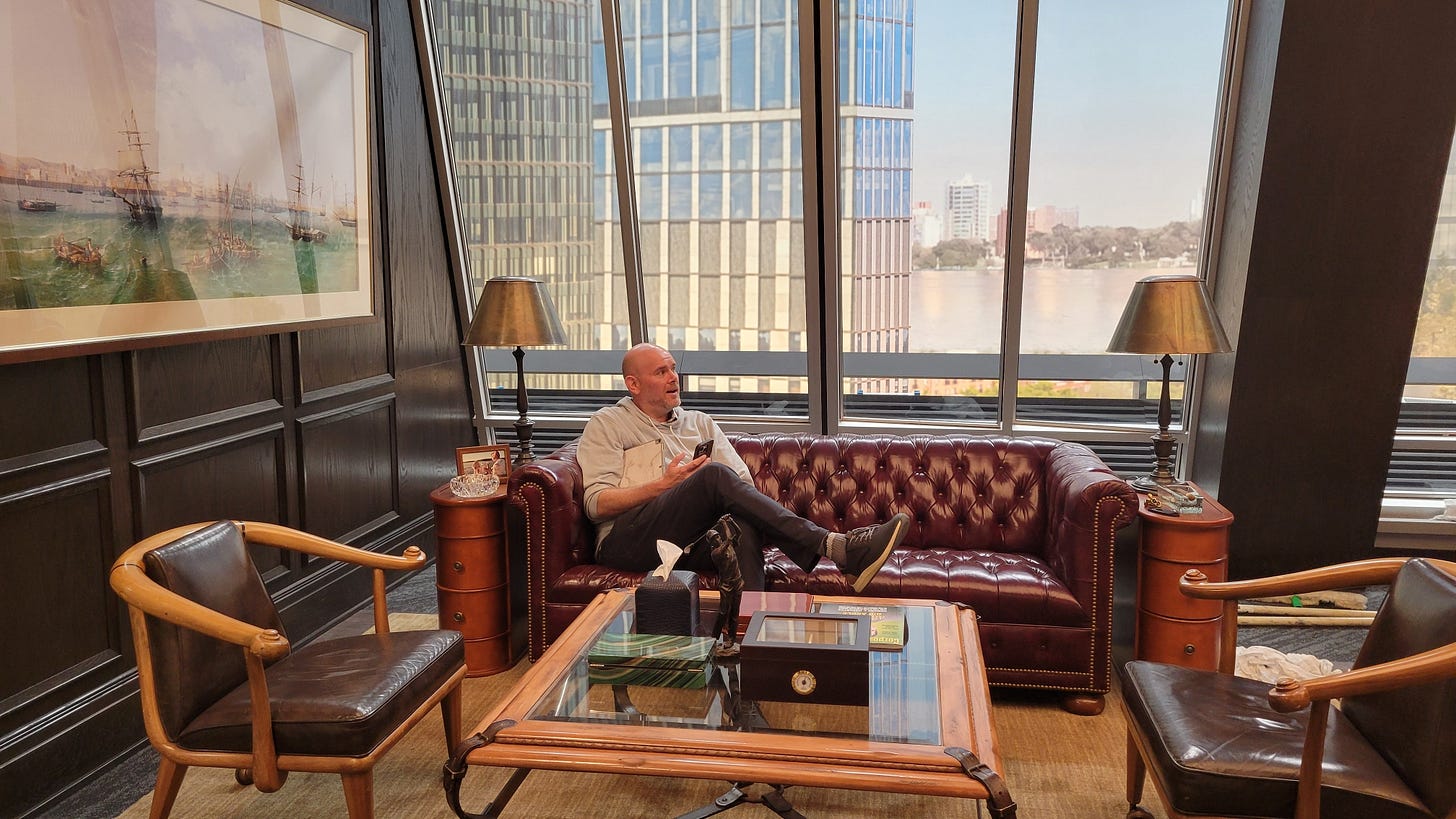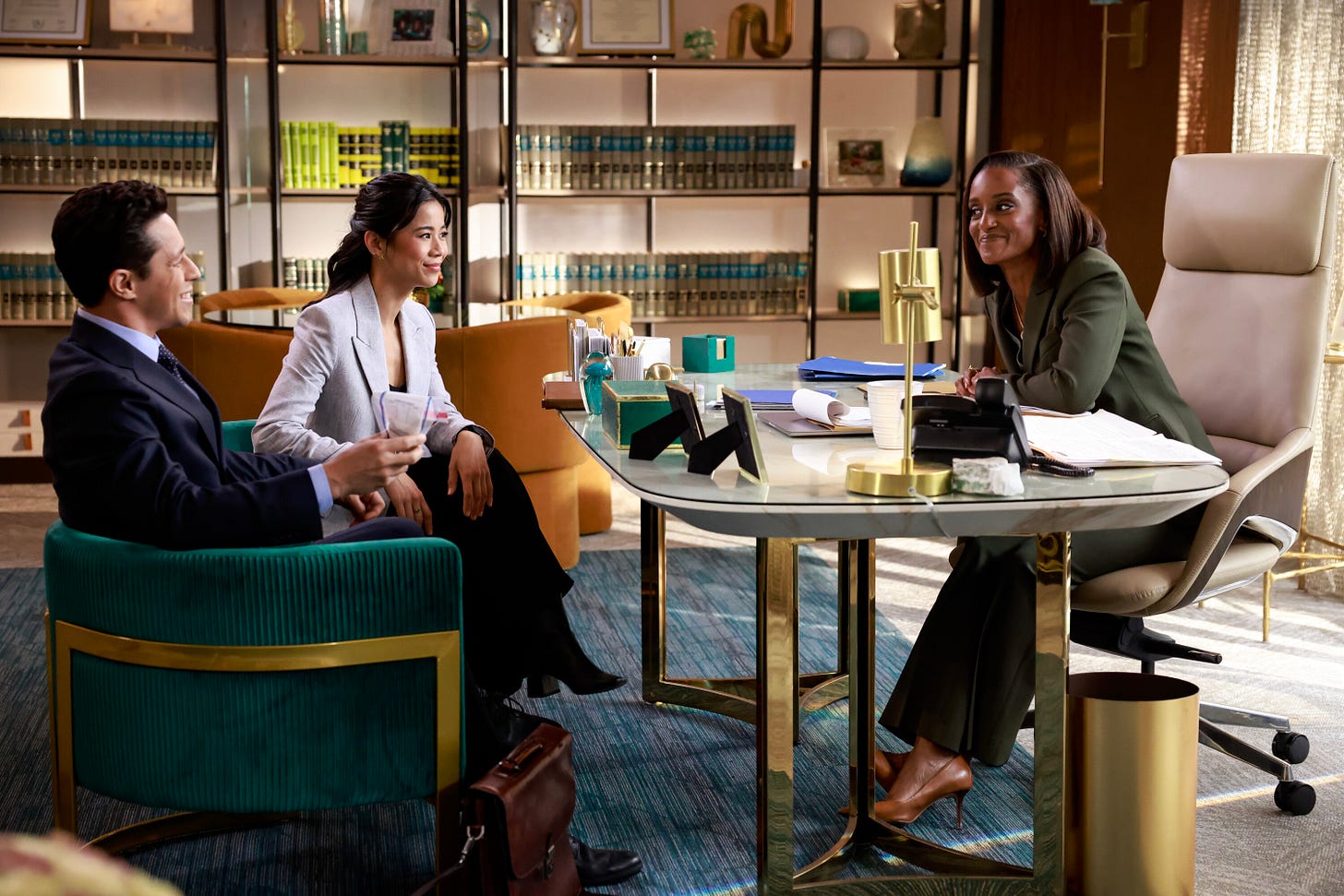'It's Lying to You': Matlock Production Designer Adam Rowe on Intentionally Unsettling Sets
Yes, Redditors, he has seen your concerns. It's all part of the big dupe.

Welcome to the wild and wonderful era of Emmy Awards: Phase 1, a time before nomination voting when the arbitrary rules governing what is timely are set aside, and we can discuss projects that were released weeks or months earlier and deserve to be top of mind again. (Sidenote: You can take these as my personal recommendations for viewing until networks start sponsoring content. Life’s too short to write about nonsense without getting paid for it.) Matlock premiered on CBS September 22, 2024.
The law offices of Jacobson Moore on CBS’ Matlock have a surprisingly fabulous antecedent—they started life as the home of Madolyn Ashton’s cosmetics empire on the short-lived Netflix series Glamorous. But that wasn’t the first time production designer Adam Rowe utilized that steel and glass.
What initially started life as a hospital set for the Fox drama Good Sam ultimately became the offices at the center of Glamorous (a show that features more Moonlighting Easter eggs than even I could catch, including Rowe mimicking the layout of Maddie Hayes’ office for Kim Cattrall’s cosmetics maven). And then during the strike, when the team found out the show was canceled, Rowe couldn’t let the sets go.
”I had heard that they were gonna throw the set away, and I just couldn't stand the idea of that,” Rowe says. After many texts and phone calls and scheduling, Rowe managed to stop the dumpsters and get the sets shipped to Los Angeles. “Two semi-trucks full of scenery,” he says. “And it became Matlock. That's how the infrastructure came to be. And if it wasn't for the foundation of Good Sam, the adds from Glamorous, and the sophistication of Matlock, we wouldn't have Good Glam Lock, as I call it.”
As Rowe points out, every production talks a big game when it comes to being as eco-friendly as possible—but the follow-through can be lacking, which makes his work here particularly satisfying. ”We saved $300,000 plus on steel and glass at the end of the day, materials-wise,” he says. “And the labor's the same: Are you gonna move it from the stage to a dumpster or are you gonna move from the stage to a truck? And so that's been really fun to work out. And that is probably the best thing about the Matlock set, not just because of the environmental component, but it benefited because of those other shows.”
Matlock might be one of the unlikelier success stories of the recent TV season—although maybe we’re all just ready for the comfortable delights of a smartly done procedural. Especially one with as many layers as this new take on the old Andy Griffith series. Now starring Kathy Bates as a lawyer who is running a huge con, Matlock 2.0 is an opportunity to watch a case of the week series while also engaging with plotlines about the opioid epidemic, wrongful imprisonment, targeted marketing, and more hot-button topics that are comfortably wrapped in the rhythms of network TV.
With only 18 days (including weekends) from joining the show to the start of production, Rowe had to make quick, smart decisions fast. Riffing on the very concept of the show (an homage to a bygone TV classic that is hiding a smart, sophisticated conversation about socio-political issues much the way Mattie Matlock is hiding her true intentions beneath a folksy exterior), Rowe and his team focused on creating a sense of order and structure throughout Jacobson Moore.
”A lot of thought went into why the color palette is so precise, and it's because the old Matlock was working on a formula and the new Matlock was turning that formula upside down,” Rowe said. “We still needed to play with the audience about what they were feeling when they watched the show. And it's lying to you, it's basically always lying to you. So by making people feel comfortable in their subconscious about what the colors are, it's all part of the big dupe.”
And yes, Redditors, Rowe has seen your complaints about the Winchester House-esque design of the offices. It’s intentional.
“One of the most fun things to design in the show is not being consistent with continuity,” Rowe says. “Which has driven people crazy. If you read Reddit, people are paying attention. ‘Oh, this door wasn't here, or this staircase wasn't there. Or, wait a minute, isn't Julian supposed to be on a different floor?’ All that's intentional. There's almost no names on anyone's desks. There's almost no numbers. We hardly ever show what floor they're going to. It's because we want to keep the audience always off their game, and that's the subtle way that the design is doing that.”
The design itself mimics the moment at the end of most Matlock episodes, where flashbacks reveal the snippets of scenes that we didn’t see, moments where Mattie has plotted out exactly how to outwit the denouement we expected to see unfolding.
That’s another reason the show builds so many sets; the clue-laden scenes all require more precision than location shooting could allow at the pace of a network series. That also allows Rowe to get… interesting with creating spaces we’ve all seen hundreds of times.
”People do not watch Matlock to reflect reality. It's not what's going on in Matlock,” Rowe says. “It's a fun puzzle. It's a game, but it has to be contextualized to feel real because Kathy's acting her guts out, and Skye’s acting her guts out. You need to give them a place that feels as realistic as their emotions. I also want to raise the stakes. That's how I approach every single set: ‘OK, what puzzle piece and what surprise and delight can I give the audience?’”
One of the biggest surprises in terms of production design came at the end of the first episode, when Mattie Matlock reveals herself as the well-to-do Madeleine Kingston, who lives in a staggering Westchester mansion.
“I kept getting the note from Jennie Snyder Urman, the showrunner who guided me on all of this stuff, ‘Think Oprah Winfrey. Like, really think Oprah Winfrey. She’s got that much money.’ So that's how we guided ourselves to this insane mansion, which turns out to be Shane Black's house, by the way, who wrote The Predator. So that's just a weird, funny piece of trivia.”
Rowe’s second career as an art director served him well for the 18 episodes of Matlock because it made him savvier about budgets—and problem-solving.
”We had to build a lot more scenery in the middle of the season, and I think my art director skills kicked in to be like, okay, how can I flip and I turn things?’ The perfect example is that the Madeleine bedroom and the Madeleine office share the same footprint on a sound stage, and we change them out overnight.”
Hopefully, that won’t be as much of an issue in Season 2, since Madeleine took down the elaborate crime board in her home office in the finale. “I don't wanna take full credit for it, but I think it was my idea to throw the champagne bottle at the crime board, and I was hoping that meant the end of it,” Rowe says. “There is one fun Easter egg in there. Joanna Klein, who's part of [production company] Sutton Street, she’s on that board. We wanted to get Eric Christian Olsen, the actor from NCIS who's also one of the producers, on there. But somebody was like, “He’s too recognizable, we can't do that.”
Adam Rowe is a four-time ADG nominee and Emmy Award-winning art director and production designer whose credits include The Good Place, Rent: Live, Rizzoli & Isles, and Glamorous. He submitted Episode 1 of Matlock for Emmy Award consideration. His go-to at crafty? “ Most places have that warm chocolate chip cookie. That one's always a big hit for me. And I was not a sparkling water drinker until Matlock. And now as you see, I've become addicted.”




